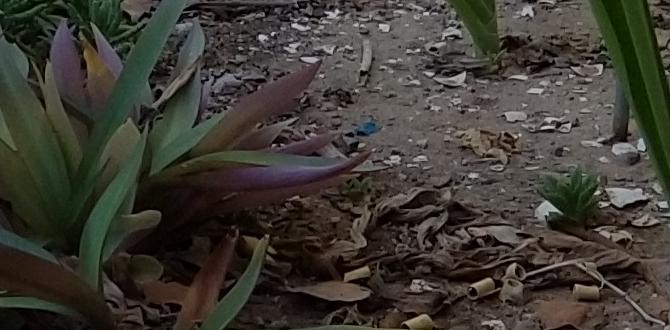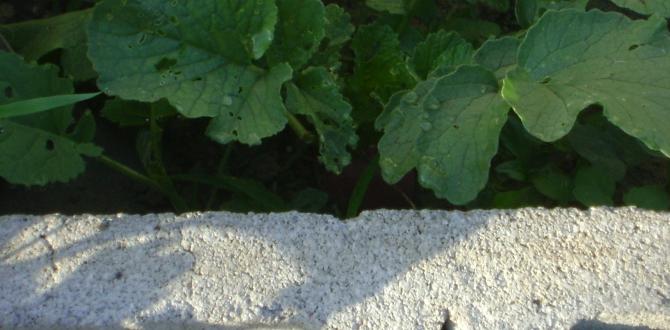Have you ever seen a garden that dazzles with life? Imagine adding a unique touch to your outdoor space. Cinder blocks for gardening might just be your secret ingredient!
Many people overlook these simple blocks. Yet, they can offer both beauty and function. Did you know you can use cinder blocks to create garden beds, planters, or even garden paths? It’s true! With a little creativity, cinder blocks turn into amazing gardening tools.
Picture this: instead of buying pricey pots, you stack cinder blocks to form a neat flower bed. Each hole provides a spot for a small plant. You save money and add a creative flair to your garden. How cool is that?
Using cinder blocks also helps plants grow healthier. The blocks retain warmth, making it easier for seeds to sprout. They can even help with drainage. This means happier plants and a more vibrant garden.
So, are you ready to transform your gardening game? Let’s explore the wonderful world of cinder blocks for gardening!
Cinder Blocks For Gardening: Versatile Solutions For Your Garden

Cinder Blocks for Gardening
Cinder blocks are a surprising choice for gardens. They come with many benefits! First, they create strong, sturdy raised beds. This makes planting easier and helps with drainage. Plus, you can add soil and plants right into the block holes for extra growing space. Did you know they can even help keep pests away? Using cinder blocks lets gardeners combine function with creativity. Why not give your garden a unique twist with these versatile blocks?Benefits of Using Cinder Blocks in Your Garden
Durability and Longevity. Versatility for Various Gardening Projects.
Cinder blocks are strong and last a long time. They can handle different weather easily. This makes them great for your garden. You can use them for many projects like raised beds, pathways, or even garden walls. Their sturdy nature means they won’t break down quickly. You can create a unique space that carries your style.
- Durable and long-lasting
- Great for many garden designs
- Helpful for creating borders
- Easy to stack and arrange
What are the key benefits of cinder blocks for gardening?
The main benefits are durability and versatility. They last through harsh conditions and can fit various gardening needs.
Creative Ways to Use Cinder Blocks in Gardening
Raised Garden Beds. Vertical Gardens and Green Walls.
Cinder blocks work great for garden projects! For raised garden beds, they create strong borders. Simply stack them to hold soil and plants. You can grow all kinds of veggies, making harvesting easy. Another fun use is for vertical gardens. Arrange blocks on a wall to make unique green walls. These spaces are perfect for flowers and herbs. This way, you save space while still beautifying your garden!
What are some uses for cinder blocks in gardening?
You can use cinder blocks to build raised beds and vertical gardens. Raised beds help plants thrive with better drainage. Vertical gardens save space and add beauty to walls.
Benefits of using cinder blocks in gardening:
- Durable and long-lasting
- Easy to arrange
- Good for soil drainage
- Stylish in design
How to Choose the Right Cinder Blocks for Your Garden
Different Types of Cinder Blocks. Factors to Consider: Size, Weight, and Aesthetics.
Choosing the right cinder blocks for your garden can make a big difference. Start by knowing the different types available. They can vary in colors and textures, affecting their look. Consider these important factors:
- Size: Bigger blocks can hold more weight.
- Weight: Lighter blocks are easier to move.
- Aesthetics: Pick blocks that match your garden style.
Doing some homework helps. Think about what fits your needs best. This choice will make your garden both strong and beautiful!
What types of cinder blocks are best for gardening?
The best types for gardening include standard concrete blocks and decorative options. Standard blocks are strong and useful for walls. Decorative ones look good and add style.
Building Techniques for Cinder Block Garden Structures
StepbyStep Guide to Constructing Raised Beds. Tips for Proper Drainage and Soil Retention.
Creating raised beds with cinder blocks is like playing with giant Lego bricks. First, gather your cinder blocks and choose a sunny spot in your yard. Stack the blocks in a rectangle, leaving space for plants to breathe. Don’t forget drainage! Drill small holes at the bottom to let excess water escape. Add rocks or gravel first, then fill with rich soil to keep your veggies happy. Always remember, even plants appreciate a light shower!
| Step | Action |
|---|---|
| 1 | Choose a sunny location. |
| 2 | Stack cinder blocks into a rectangle. |
| 3 | Drill drainage holes. |
| 4 | Add gravel or rocks for drainage. |
| 5 | Fill with soil for planting. |
A well-built raised bed can give you a great garden with proper drainage and soil retention. Happy gardening!
Incorporating Plants with Cinder Blocks
Best Plants for Cinder Block Gardens. How to Design Your Plant Layout.
Using cinder blocks for gardening can create a unique and fun garden space. Some of the best plants for these gardens include:
- Succulents
- Herbs like basil and parsley
- Vegetables such as lettuce and tomatoes
To plan your layout, think about how tall or wide each plant grows. Place shorter plants in front and taller ones in back. This way, all your plants can get sunlight. Your garden will look colorful and attractive!
What are the best plants to grow in cinder block gardens?
The best plants include succulents, herbs, and vegetables. These plants thrive in the blocks’ unique setup.
How should I design my plant layout?
Design your layout by placing taller plants in the back and shorter plants in front. This allows each plant to get enough sunlight and grow well!
Maintenance Tips for Cinder Block Gardens
Ensuring Structural Integrity. Managing Soil and Plant Health.
Keep your cinder block garden standing tall! Check for cracks often; they can sneak up on you like a ninja. For soil health, mix compost into your garden beds. This boosts nutrients, helping plants grow big and strong. Don’t forget to water regularly, but not too much—plants hate swimming! Finally, remove weeds like they’re that last slice of pizza—gone before you know it!
| Tip | Description |
|---|---|
| Check for Cracks | Inspect cinder blocks regularly to ensure they’re intact. |
| Add Compost | Mix into soil to enhance plant nutrition. |
| Water Wisely | Keep the soil moist, but avoid overwatering. |
| Weed Control | Remove weeds promptly to protect your plants! |
Cost-Effective Gardening with Cinder Blocks
Budgeting for Your Cinder Block Projects. Finding Affordable Cinder Block Sources.
Gardening with cinder blocks can save you some serious cash! First, set a budget. Decide how much you want to spend on your cinder block projects. Remember, the more you plan, the less you overspend. To find affordable cinder blocks, check local hardware stores or online marketplaces. Sometimes, people sell used blocks for even less! It’s like finding treasure in your neighborhood. Here’s a quick look:
| Source | Price Range |
|---|---|
| Local Hardware Store | $1.50 – $3.00 each |
| Online Marketplaces | $1.00 – $2.50 each |
| Recycle Centers | $0.50 – $1.50 each |
So grab those blocks and start building your garden! Don’t forget—a little planning can help your garden grow without emptying your wallet!
Common Mistakes to Avoid When Using Cinder Blocks
Miscalculating Measurements. Neglecting Drainage Needs.Miscalculating measurements can lead to a garden that looks more like a jigsaw puzzle than a beautiful landscape. Always double-check sizes before you buy your cinder blocks! If your blocks don’t fit, you might have to put on your construction hat and get creative. Neglecting drainage is another big mistake. If water has nowhere to go, it can turn your garden into a swamp. Remember, even plants don’t want to swim! Proper drainage keeps roots happy and healthy.
| Common Mistakes | How to Avoid |
|---|---|
| Miscalculating Measurements | Always measure twice! |
| Neglecting Drainage | Plan for holes or gravel. |
Conclusion
Cinder blocks are great tools for gardening. They create sturdy plant beds and help with drainage. You can easily stack them to save space and add decoration. Try using cinder blocks in your garden and see how they improve your plants. For more tips on gardening with cinder blocks, check out additional resources or start your own project today!FAQs
What Are The Benefits Of Using Cinder Blocks For Gardening Compared To Traditional Soil Planting Methods?Using cinder blocks for gardening has many benefits. Cinder blocks help keep the plants safe from pests and weeds. They also create warm spaces for roots, helping plants grow better. We can easily move them around or change the garden’s shape. Plus, they look neat and tidy in your yard!
How Can I Effectively Create A Cinder Block Garden Bed For Growing Vegetables Or Flowers?To make a cinder block garden bed, start by choosing a sunny spot in your yard. Lay the cinder blocks in a square or rectangle shape. Fill the inside with soil that is good for growing plants. You can plant flowers or vegetables in the soil. Make sure to water them regularly to help them grow!
What Plants Are Best Suited For Gardening In Cinder Blocks, And How Does The Structure Affect Their Growth?For gardening in cinder blocks, you can grow herbs like basil and mint, and vegetables like lettuce and radishes. The holes in the cinder blocks let them get enough water and drain well. This helps the plants grow strong roots. You can also use the blocks to make a cool garden design!
Are There Any Considerations For Drainage And Moisture Retention When Using Cinder Blocks In A Garden?Yes, we need to think about drainage and moisture when using cinder blocks in a garden. Cinder blocks can hold water if not placed well. To help, you can leave spaces in the blocks for extra water to escape. We can also fill the bottom with gravel to help with drainage. This way, plants can get the water they need without getting too soggy.
How Can I Creatively Design A Cinder Block Garden To Enhance Aesthetics While Maintaining Functionality?To make your cinder block garden look nice and work well, start by painting the blocks bright colors. You can arrange them in fun shapes, like a zigzag or a circle. Fill the holes in the blocks with flowers or herbs. Add decorations, like garden gnomes or small lights, to make it even prettier. This way, your garden will be both beautiful and useful!






